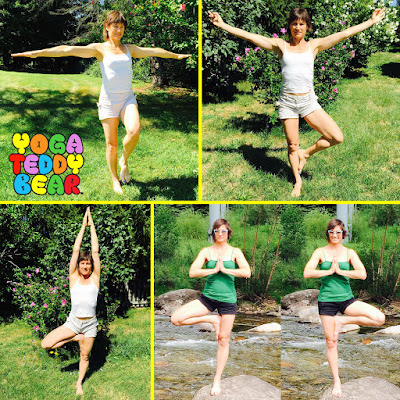Kids love it. It’s
the first pose most people strike when they hear the word “yoga”. It even enjoys its own special day of the
week complete with hashtag (#TreePoseTuesday.)
Tree Pose strengthens your legs, flexes your angles, and lengthens your
spine. Most importantly, Tree Pose
maintains and improves your balance. And
the best thing about Tree Pose is almost anyone can do it.
B. K. S. Iyengar’s legendary “Light on Yoga” progression
features Tree Pose as #2 in a series of 200 progressively difficult poses. It’s second only to Mountain Pose, or active
standing. So if you can stand up, can
probably do Tree Pose. This is why it’s
difficult for little kids. They haven’t
been standing that long.
As we age, standing and balancing can become increasingly
difficult. But by standing on one foot
for just one minute (30 seconds per day per foot), most adults will maintain a
sense of balance throughout their life. It sounds like a preposterous claim, but try it for 30 seconds – if
you’re younger than 7 and older than 70, it may not be so easy to balance on
one foot for a whole 30 seconds. And
because people are different, it may not be easy for you whatever your age is.
1. Keep your feet on
the ground. If balancing is a challenge for you, begin with your one foot
firmly planted on the ground. Imagine you
are a tree, with roots that reach down from the bottom of your foot into the
earth. Tune into the sensation of your
foot making contact with the ground. Lift the heel of your other foot so you are balancing on tiptoe. Lift your arms up and spread them like the
branches of a tree. Feel your sense of balance.
Find a point straight ahead of you on which to focus your
gaze. Perhaps use a clock with a second
hand so you can time yourself. Lift your
right toes off the floor so you are standing on one foot. Congratulations, you’re in Tree Pose! After 30 seconds, set your foot down and
follow the same progression on you’re the other side.
2. Move your foot to
your calf. Once you feel confident standing on one foot, you can progress
up the Tree Pose ladder. The next rung
is putting the bottom of your foot on the inside of your leg at the calf. It is very important not to place your foot
on your knee, as you risk the possibility of joint dislocation. Also important is to keep your toes pointing
down or even slightly toward the back, not forward. This action will gently open your hips.
3. Move your foot to
your thigh. If the first two levels were easy for you, reach down and grab your
foot. Place your right heel at the root
of your left thigh. See if you can hold
your leg in place using your muscles and not your hands. It helps to wear shorts or non-slippery
pants.
Once you’ve freed your hands, place your palms together in
front of your chest. Gently press them
together to further engage your lateral balance. Or you can opt to keep your palms together
and raise them overhead with your arms straight in a slightly more challenging
version of Tree Pose.
4. Set yourself free. Now play with it! Go
in and out of a full Tree Pose without using your hands at all. Can you get your foot to your calf or your inner
thigh without grabbing your foot? Can
you move from another balancing pose, such as Half Moon or Eagle Pose to Tree
Pose and back? These are all fun ways to
improve your balance and your mastery of The Most Popular Pose. To stay balanced
remember to spend equal amount of time on each side.
Tree Pose is a natural and foundational way to balance. I love to find my Tree Pose in unique
settings like on rocks or logs. Just
like anything, practice will result in improvement. Most importantly, whatever you do with your
body should be fun. And as most kids
will tell you, Tree Pose definitely makes the cut!



No comments:
Post a Comment